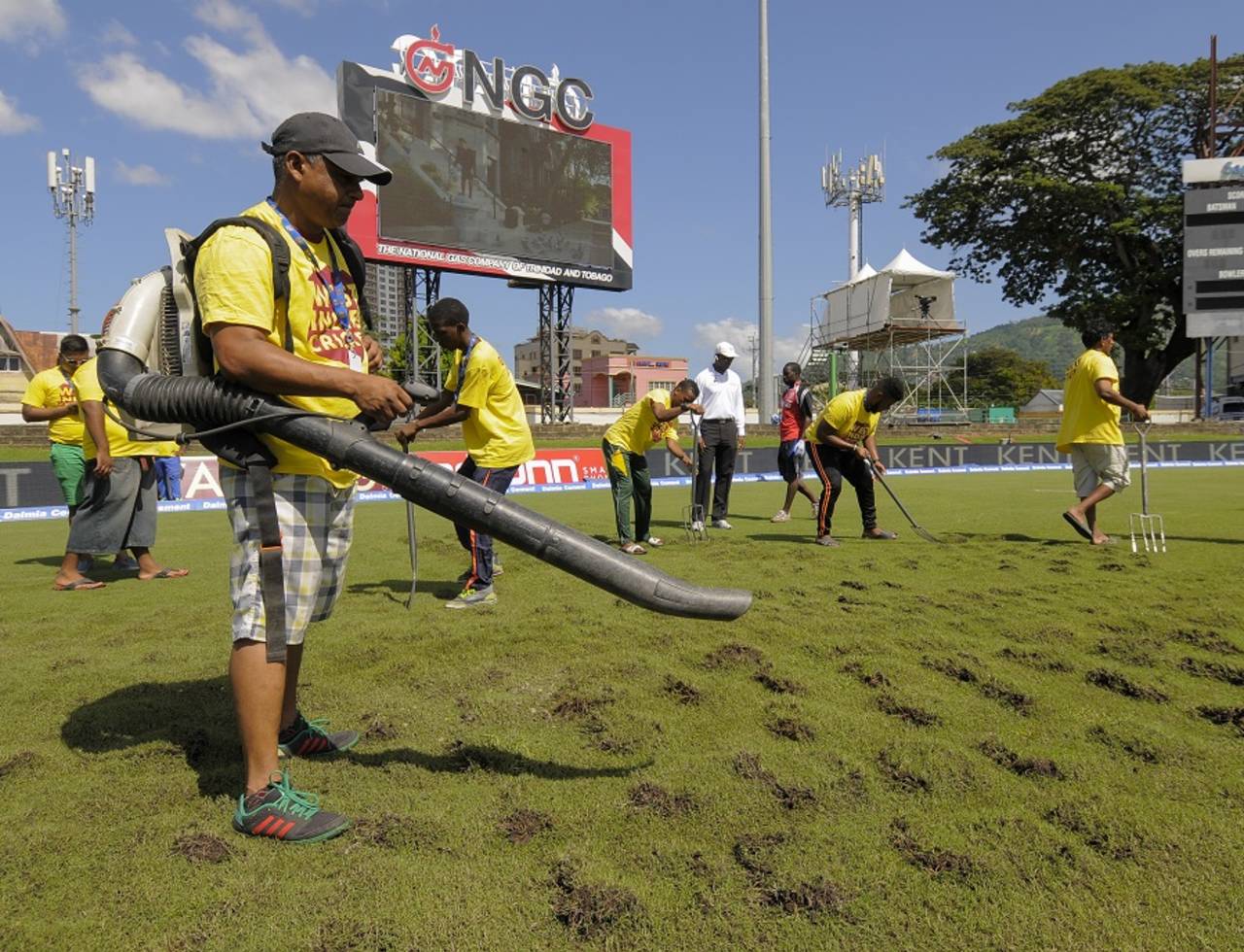Authorities exposed by lack of covers
Foolish logistical planning paired with inadequate drainage infrastructure meant no play on days two and three at Queen's Park Oval despite mostly sunny skies
Karthik Krishnaswamy in Port of Spain
20-Aug-2016

Stick a fork in it: The outfield drainage at Queen's Park Oval hasn't been up to scratch • AFP
At approximately 11.30 am on Saturday morning, a batch of pitchforks and shovels arrived at the Queen's Park Oval. They were brand new, still in their clear plastic wrapping. For over two hours leading up to that moment, the groundstaff had been hard at work with the stadium's existing stock of tools, training their attentions on a patch of the outfield near the western square boundary. They were breaking up its top surface and subjecting it to jets of hot air from blowers that looked like vacuum cleaners mounted on backpacks.
This patch of turf was as long as a pitch, roughly, about twice as wide, and saturated with moisture that simply refused to go away. By breaking it up, the groundstaff were hoping to increase the surface area exposed to the sun and their blowers, and thereby speed up the drying process.
It was day three of the fourth Test between West Indies and India, and not a drop had fallen all day. Apart from a brief shower in the afternoon, there had been no rain on day two either. Two nearly rain-free days, and play was nowhere near starting because parts of the outfield were still damp.
Almost exactly when the new pitchforks and shovels came out of their wrapping, a dark cloud appeared over the Oval, and covers came onto the field. On day one, when rain stopped play after just 22 overs, the groundstaff had only covered the pitch and the rest of the square. Now, apart from the square, they had covered the bowlers' run-ups as well. Apart from its regular blue covers, the Queen's Park Oval had acquired a pair of fluorescent yellow ones too.
They were the same colour as the ink of a highlighter pen applied over the words "too late". For when they arrived in the morning, the umpires had been just as concerned by the run-up areas as they had been by the damp patch near the square boundary.
In order to minimise rain delays, some grounds around the world have begun covering their entire outfield. Here, in a Test match scheduled during the wet season, the Queen's Park Oval had only begun covering the run-ups on day three. The ground did not own a super sopper either.
The third Test in St Lucia lost an entire day to rain that was heavier than the downpour Port of Spain experienced on day one. It left the exposed parts of the outfield totally sodden. But play managed to begin at 10am the next morning. The Darren Sammy National Cricket Stadium owned a super sopper and, perhaps more importantly, its drainage was able to handle a large volume of rain.
The drainage at the Queen's Park Oval simply seemed inadequate to host a Test match scheduled in the wet season. A major pity, since crowds at the two washed-out days have been far bigger than any seen in the series so far. On the third day, a group of schoolchildren were at the Scotiabank stand, right behind the sodden, dug-up patch of outfield. Some of them must have been coming to watch their first ever day of Test cricket. They probably did not enjoy it.
But perhaps the biggest reason for the ground's failure to drain properly was simply the amount of rain it has taken over the last few weeks. It has rained consistently through August, and August is always a wet month. On average, according to the World Meteorological Organisation, Port of Spain receives 244 mm of rain in August, more than in any other month. Scheduling a Test match here now was perhaps not the wisest decision in the first place.
It has never happened before. Of the 60 Test matches the Queen's Park Oval has hosted, this was the first to be played in August. The venue has never staged a Test in July, only two - in 2010 and 2014 - in June, and only one, back in 1965, in May. The other 56 Tests have all been played between January 19 and April 26, in the dry season, in West Indies' traditional cricket season.
But once the series had been scheduled, the authorities responsible for staging the Test match - the whole chain running from the WICB through the Trinidad & Tobago Cricket Board to the Queen's Park Cricket Club, which owns the ground - could have made the best possible arrangements to minimise the rain's impact. They did not have time to overhaul the ground's drainage, and may not have been able to acquire a super sopper either, but they could definitely have rushed to the nearest dealer in outfield covers and picked out a nice, colour-coordinated set.
Karthik Krishnaswamy is a senior sub-editor at ESPNcricinfo